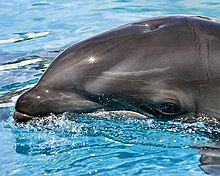Wholphin
| Wholphin | |
|---|---|
 | |
| Kawili Kai, born to a female wholphin by a male dolphin, at 9 months of age in September 2005 | |
| Scientific classification | |
| Domain: | Eukaryota |
| Kingdom: | Animalia |
| Phylum: | Chordata |
| Class: | Mammalia |
| Order: | Artiodactyla |
| Infraorder: | Cetacea |
| Superfamily: | Delphinoidea |
| Family: | Delphinidae |
| Hybrid: | Tursiops truncatus × Pseudorca crassidens |
A wholphin (portmanteau of whale and dolphin) is an extremely rare cetacean hybrid born from a mating of a female common bottlenose dolphin (Tursiops truncatus) with a male false killer whale (Pseudorca crassidens).[1] The name implies a hybrid of whale and dolphin, although taxonomically, both are within the oceanic dolphin family, which is within the toothed whale parvorder. This type of hybrid was considered unexpected given the sometimes extreme size difference between a female common bottlenose dolphin (typically 2 meters long and 300 kilograms) and a male false killer whale (over 5 meters long and over 1,800 kilograms). Wholphins have been born in captivity and have also been reported in the wild.[2]
Examples[edit]

The first recorded wholphin was born in a Tokyo SeaWorld in 1981; he died after 200 days.[3]
The first wholphin in the United States and the first to survive was Kekaimalu, born at Sea Life Park in Hawaii on May 15, 1985; her name means "from the peaceful ocean".[3] Kekaimalu proved fertile when she gave birth at a very young age. The calf died after a few days. In 1991, Kekaimalu gave birth again, to her daughter, Pohaikealoha. For two years, she cared for the calf, but did not nurse it; it was hand-reared by trainers. Pohaikealoha died at age 9. On December 23, 2004, Kekaimalu had her third calf, daughter Kawili Kai, sired by a male bottlenose. The calf did nurse and was very playful. Only months after birth, it was the size of a one-year-old bottlenose dolphin.[4] All three calves were three-quarters bottlenose dolphin and one-quarter false killer whale.[5] As of March 2020[update], Kekaimalu and Kawili Kai remain in captivity in Sea Life Park.[6]
Family tree[edit]
| Tanui Hahai (false killer whale) ♂ | Punahele (bottlenose dolphin) ♀ | ||||||||||||||||||||||||||||||||||||||||
| Unknown dolphin ♂ | Kekaimalu (wholphin) ♀ | bottlenose dolphin ♂ | |||||||||||||||||||||||||||||||||||||||
| Unnamed calf | Pohaikealoha ♀ | Kawili Kai ♀ | |||||||||||||||||||||||||||||||||||||||
References[edit]
- ^ "First ever 'wholphin' hybrid spotted in wild". Sky News. July 31, 2018. Retrieved September 28, 2023.
- ^ "Whale-dolphin hybrid has baby wholphin". NBC News. April 15, 2005.
- ^ a b West, Karen (May 18, 1986). "A Whale? A Dolphin? Yes, It's A Wholphin". Chicago Tribune. Archived from the original on March 20, 2014. Retrieved July 9, 2013.
Born at Sea Life Park on May 15, 1985, Keikaimalu was referred to as a wholphin by Sea Life Park's training staff.
- ^ Sean B. Carroll (September 13, 2010). "Remarkable creatures: Hybrids may thrive where parents fear to tread". New York Times. Retrieved September 14, 2010.
The first captive wholphin, Kekaimalu, was born on May 15, 1985, to a female bottlenose dolphin named Punahele, who shared a pool with a male false killer whale named Tanui Hahai. The wholphin's size, color and shape are intermediate between the parent species. She has 66 teeth – intermediate between a bottlenose (88 teeth) and false killer whale (44 teeth)
- ^ "Ditching SUVs and Breeding Beefalos". E Magazine. 17 (1): 64. January–February 2006. Archived from the original on July 2, 2013. Retrieved May 4, 2013.
- ^ "Animal profiles: Dolphins & whales". Sea Life Park Hawaii. December 24, 2014. Retrieved March 25, 2020.
External links[edit]
- Waimanalo Hapa Girl Makes 10! at Internet Archive, by Keene Rees


 French
French Deutsch
Deutsch